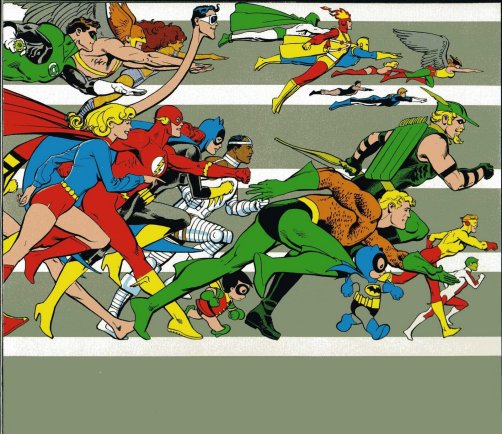
Welcome to another edition of Into the Bronze Age! With this post we’ll finish of September of 1971. Our last two books are really quite a pair! We have an unusual issue of World’s Finest, but the real highlight (lowlight?) here is the raw star power of the greatest new superstar in the DC constellation….I’m speaking, of course, of Don Rickles. That’s right, this month we get more of the inexplicable madness of Kirby’s use of the insult comic as a guest star in Jimmy Olsen. Yay? Well, see what sense you can make of what lies within!
Roll Call
(You can see everything published this month HERE)
- Action Comics #404
- Adventure Comics #410
- Batman #235
- Brave and the Bold #97
- Detective Comics #415
- The Flash #209
- Forever People #4
- G.I. Combat #149
- Justice League of America #92
- New Gods #4
- Superboy #177
- Superman #242
- Superman’s Girlfriend, Lois Lane #113
- Superman’s Pal, Jimmy Olsen #141
- World’s Finest #205
Bolded entries are covered in this post, the others will be covered soon.
Superman’s Pal, Jimmy Olsen #141
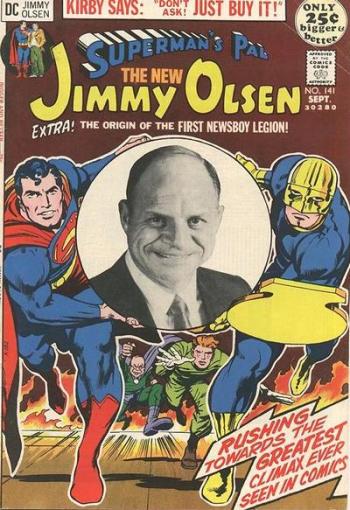
“Will the Real Don Rickles Panic?”
Writer: Jack Kirby
Penciler: Jack Kirby
Inker: Vince Colletta
“The Guardian”
Writer: Joe Simon
Penciler: Jack Kirby
Inker: Joe Simon
Ohh man, for a moment there as I was looking from Lois Lane to my next book, a moment of blissful forgetfulness, I was excited for more of Jack Kirby’s wild and wonderful Jimmy Olsen adventures…and then I remembered that this one was the second half of the Don Rickles fiasco. If you thought the last issue was strange, just wait; you ain’t seen nothing yet! We start with an almost decent cover, in that classic, ‘heroes introducing a new character’ fashion that JLA and other books did from time to time. Unfortunately, this one has Don Rickles on it, which is bad enough, but even worse, it is a black and white picture of the guy. I’m never a fan of mixing real photos, especially black and white ones, with comic art in such a way. It is just incredibly incongruent. It looks like someone cut the center out of the cover and pasted Rickles’ mug into the hole.

 Despite the ugly cover, the first images that greet a reader inside are really quite impressive. Kirby is experimenting with his photo-collages again, trying to create an otherworldly effect for Clark Kent’s journey into the strange alternate dimension in the booby-trapped capsule from the last issue. The result is pretty striking and successfully cosmic. After floating helplessly for a time, the mild mannered one is visited by Lightray, who eventually rescues him. Yet, Clark doesn’t escape before he gets a brief glimpse of New Genesis and Apokolips in their great cosmic dance. This brief interaction is really cool and, sadly, way more interesting than what takes the bulk of the comic’s focus.
Despite the ugly cover, the first images that greet a reader inside are really quite impressive. Kirby is experimenting with his photo-collages again, trying to create an otherworldly effect for Clark Kent’s journey into the strange alternate dimension in the booby-trapped capsule from the last issue. The result is pretty striking and successfully cosmic. After floating helplessly for a time, the mild mannered one is visited by Lightray, who eventually rescues him. Yet, Clark doesn’t escape before he gets a brief glimpse of New Genesis and Apokolips in their great cosmic dance. This brief interaction is really cool and, sadly, way more interesting than what takes the bulk of the comic’s focus.
 While the reporter roves around in the Fourth World, his three friends, Jimmy Olsen, the Guardian, and…urg…”Goody” Rickles, find themselves deposited on the side of the road by Intergang, poisoned and facing a fiery fate. The cloned hero sends the other two to seek help at the nearest hospital….ohh, wait, no. That might make sense. He sends them to the Daily Planet instead. The Guardian himself sets off after the villain’s rolling headquarters to capture an antidote, and Kirby treats us to a few panels of his revived Golden Age hero leaping rooftop to rooftop in classic fashion.
While the reporter roves around in the Fourth World, his three friends, Jimmy Olsen, the Guardian, and…urg…”Goody” Rickles, find themselves deposited on the side of the road by Intergang, poisoned and facing a fiery fate. The cloned hero sends the other two to seek help at the nearest hospital….ohh, wait, no. That might make sense. He sends them to the Daily Planet instead. The Guardian himself sets off after the villain’s rolling headquarters to capture an antidote, and Kirby treats us to a few panels of his revived Golden Age hero leaping rooftop to rooftop in classic fashion.
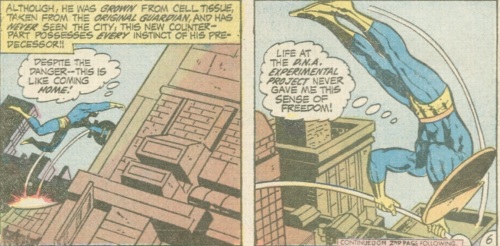
Meanwhile, the actual focus of the plot nears, as Morgan Edge prepares for the arrival of the real Don Rickles in his office. When the comedian shows up, he’s mobbed by the staff in an admittedly funny scene, where they all beg to be insulted. Unfortunately, I’d say that’s the last unambiguously funny bit in the book. After the corporate shark chases off his underlings, he leads the star into his office, where his dialog becomes part comedic and part chaotic nonsense.
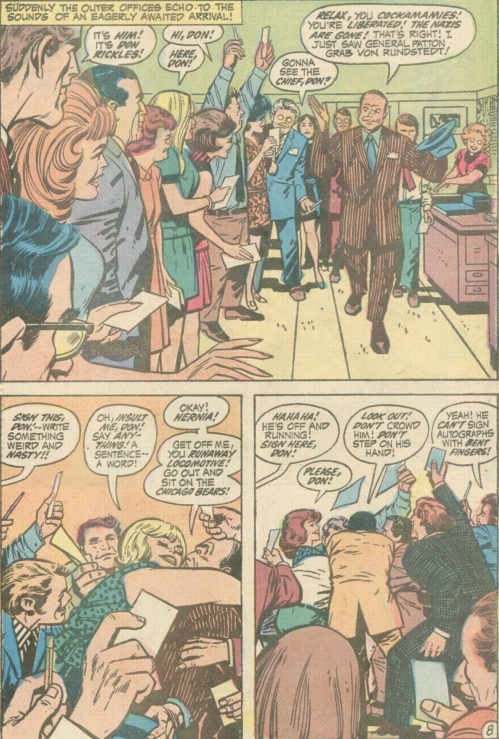
While those two talk business (I guess?), Jimmy and Rickles’ inexplicable doppelganger are taking the subway, where Goody’s agitation causes the chemical in his system to react and start him smoking. There’s some funny bits to this, but I can’t help but wish we were visiting one of the more interesting plotlines instead. Fortunately, we quickly return to the Guardian, who smashes his way into “Ugly” Mannheim’s mobile base. He lays into the gangster’s gunmen, but we cut away from his fight for….*sigh*….more Rickles. Double the Rickles, in fact, as Goody arrives at the Planet, where he and the original engage in some “funny” hijinks about how they are identical.
As Goody and Jimmy approach critical mass, glowing and emitting flames, Morgan Edge calls for the bomb squad while silently cursing Mannheim. Disaster is averted (although, other than Jimmy’s death, would it really have been that much of a loss?) by the timely arrival of the Guardian, who crashes through a window with the antidote in wonderfully dramatic fashion. How did the cloned champion overcome all Mannheim and his criminal cohorts? Well, we don’t get to see that. Nope. It’s way more important that we watch Don Rickles chew scenery. As the comedian hams it up, Clark Kent returns via a boom tube and the bomb squad arrives and carries the frantic comedy star away.

Sheesh. There is a lot of really interesting material in this comic; the trouble is that Kirby ignores all of that to give us Don Rickles and Goody making faces at each other. Clark’s cosmic journey is quite visually interesting, and there is a lot of potential to his visit to the dimension of the New Gods, especially given his fascination with a world full of super-beings in the Forever People title, but no sooner does one of them arrive than we cut away. The same is true of the Guardian’s big return to action, where he swings through the city and single-handedly defeats the villain….almost all off panel. This issue is just a lesson in missed opportunities, as the King has absolutely packed this book with fun concepts and characters, from the Newsboy Legion to the returned Golden Age hero, and yet he wastes his narrative space on Don Rickles of all people. That being said, this issue isn’t as bad as I may have made it sound. It’s still a relatively entertaining read, though one that will have you groaning in a few places or simply scratching your head.
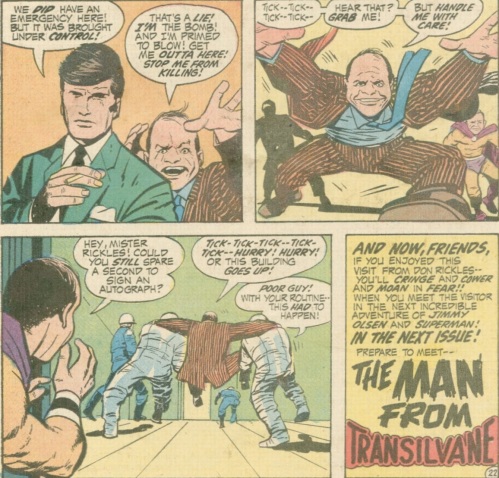
Kirby’s art, so beautifully powerful and dynamic in the last issue, is much more inconsistent in this one as well. Don Rickles himself is all over the place, and the bombastic scope of the action is more restrained, which is really a shame. There are a couple of wow moments, like Clark’s trip and the Guardian’s timely arrival, but those are sadly exceptions. So, what do we make of this mad little issue? I think I’ll give it 2 Minutemen. It has some interesting moments, but they are quickly bypassed for lesser material. The humor is better in this one, but while the plot is more coherent and less nonsensical than the previous issue, the overall effect is weaker. This outing just lacks the whimsical fun of its predecessor. Or perhaps I’m just already sick of Don Rickles
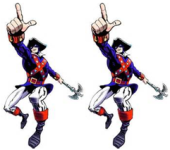
P.S.: Notably, the letters column for this issue includes a missive from a thoughtful reader who points out many of the same criticism I had about the completely unaddressed moral issues inherent in the concept of the D.N.A. Project. Even fans in 1971 could see the disturbing implications of such technologies and wanted more substance from their treatment.

 P.P.S.: This issue also features another text piece, this one on the return of the Newsboy Legion. It’s hilarious to see Mark Evanier and Steve Sherman struggle to make Flippa Dippa sound cool. As a bonus, the comic includes the first adventure of the Newsboy Legion and the Guardian from 1942, and it is a surprisingly fun and solid story that holds up well today. Jack Kirby and Joe Simon made a good team. I wish the new Guardian would get a bit of his progenitor’s personality, but then again, given that he was grown in a test-tube, I suppose it makes sense for him to be a bit bland.
P.P.S.: This issue also features another text piece, this one on the return of the Newsboy Legion. It’s hilarious to see Mark Evanier and Steve Sherman struggle to make Flippa Dippa sound cool. As a bonus, the comic includes the first adventure of the Newsboy Legion and the Guardian from 1942, and it is a surprisingly fun and solid story that holds up well today. Jack Kirby and Joe Simon made a good team. I wish the new Guardian would get a bit of his progenitor’s personality, but then again, given that he was grown in a test-tube, I suppose it makes sense for him to be a bit bland.
World’s Finest #205

“The Computer That Captured a Town!”
Writer: Steve Skeates
Penciler: Dick Dillin
Inker: Joe Giella
Cover Artist: Neal Adams
“Secret of the Last Earth-Man!”
Writer: Gardner Fox
Penciler: Mike Sekowsky
Inker: Murphy Anderson
“The Duel of the Flying Knights!”
Writer: Joseph Samachson
Penciler: Frank Frazetta
Inker: Frank Frazetta
We’ve got a very unusual team-up tale in this month’s World’s Finest. It’s really just a Superman story, with the Teen Titans serving as victims in need of rescue, but it features an interesting premise. That premises is presaged by the book’s exciting cover, one I imagine I would have been plenty tempted to pick up. I’m always a sucker for a giant monster, but Adams’ dragon, however fearsome in aspect, is a bit strangely proportioned and weird looking. I think the perspective is just a bit wonky on it. I do like how the Titans on the sidebar are all reacting to the scene in the center, though. That’s a clever use of the character preview.
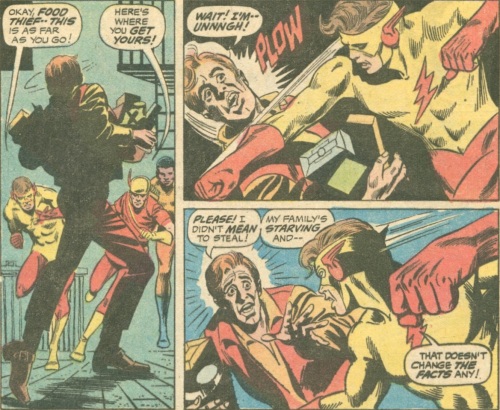
Inside, we travel to the small town of Fairfield where we join three of those young heroes, Kid Flash, Speedy (apparently taking time out from his drug-addled drama in Green Lantern), and Mal Duncan. The trio are on patrol when they see a man robbing, not a bank, not a jewelry store, nor any of the normal criminal fare, but a grocery store. Despite the fact that the poor fellow is clearly desperate, stealing to feed his starving family, they beat him savagely and show now compassion. Even more strangely, after the fight, Kid Flash and Speedy talk down to Mal, and say he better get back to his “side of town” and be with his “own kind,” and Mal meekly accepts such statements, speaking in exaggerated, minstrel show-style.

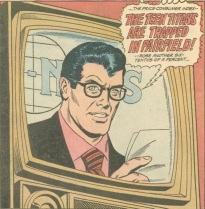 This is not the only sign that something is not right. A scene change find Wonder Girl and Lilith acting like stereotypical 50s TV girls, sitting around, pining over boys and exercising no agency in their lives. Yet, when Clark Kent shows up on TV to read the news, Lilith’s subconscious reaches out to him, and Mr. Mild Mannered has a vision of an old man discovering a strange machine in a cave and transmits the message “THE TEEN TITANS ARE TRAPPED IN FAIRFIELD!” Startled, Clark actually says that on the air, which leads to confusion from the girls and anger from everyone’s favorite corporate shark, Morgan Edge.
This is not the only sign that something is not right. A scene change find Wonder Girl and Lilith acting like stereotypical 50s TV girls, sitting around, pining over boys and exercising no agency in their lives. Yet, when Clark Kent shows up on TV to read the news, Lilith’s subconscious reaches out to him, and Mr. Mild Mannered has a vision of an old man discovering a strange machine in a cave and transmits the message “THE TEEN TITANS ARE TRAPPED IN FAIRFIELD!” Startled, Clark actually says that on the air, which leads to confusion from the girls and anger from everyone’s favorite corporate shark, Morgan Edge.
After placating his boss, Clark changes into Superman and heads out to investigate, locating his young allies just as Kid Flash is once again talking down to Mal and using super racist rhetoric. Yet, when the Man of Steel asks about their being trapped, the Fastest Boy Alive laughs the question off. The Kryptonian gets the same response from Lilith, but as he wanders around town, he begins to notice the name “Richard Handley” plastered over everything and, combined with the images from his vision, he develops a theory and heads into the hills to test it out.

Locating a cave, and having a flashback to what we just saw seven pages ago (for some reason), the Metropolis Marvel suddenly finds his way barred by a massive monster, a huge fire-breathing dragon! While Dillin’s dragon looks pretty great in most of his panels, his first appearance has his proportions a little screwy, like the cover image. Nonetheless, this starts a battle between the beast and our modern day St. George, only Superman can’t hurt the creature. He reasons that it was created by whatever machine is affecting the town, and thus, it isn’t actually real and possesses no nervous system that he can injure or vital points he can attack.
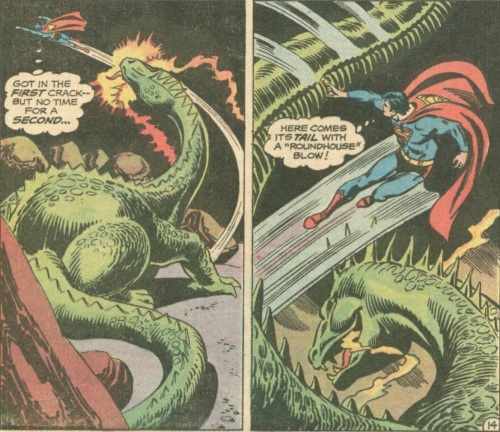
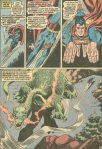 As their battle rages, the machine’s own violent energy seeps out into the town, causing the bullies to turn on the meek. Back at the cave, the Action Ace attempts to slip past the monster, but he’s caught and hurled out of the cave. Yet, his second attempt, moving at super speed, is successful, and after a nice looking fight sequence, he manages to reach and smash the mysterious machine at the heart of the town’s problems. Just then, the dragon vanishes and the world returns to normal, with the girls giving the chauvinistic Kid Flash what-for (although, methinks if the super strong Wonder Girl slapped him, he might just be in a coma) and Mal shoving Speedy’s racism down his throat. Fortunately, the boys come out of it, and they all make peace with one another.
As their battle rages, the machine’s own violent energy seeps out into the town, causing the bullies to turn on the meek. Back at the cave, the Action Ace attempts to slip past the monster, but he’s caught and hurled out of the cave. Yet, his second attempt, moving at super speed, is successful, and after a nice looking fight sequence, he manages to reach and smash the mysterious machine at the heart of the town’s problems. Just then, the dragon vanishes and the world returns to normal, with the girls giving the chauvinistic Kid Flash what-for (although, methinks if the super strong Wonder Girl slapped him, he might just be in a coma) and Mal shoving Speedy’s racism down his throat. Fortunately, the boys come out of it, and they all make peace with one another.

 Then Superman kindly provides some answers, explaining that a man named Richard Handley had discovered the strange device in the cave, which he surmises was of alien origin, some time ago, and when he touched it, the machine absorbed his thoughts and then projected them across the town, controlling the minds of its inhabitants. Notably, the Man of Steel opines that Handley was a “complicated man,” but when he describes the fellow, he doesn’t really seem all that complicated, instead, just a simple racist, chauvinistic, and provincial jerk. The only non-negative quality Supes ascribes to the guy is that he loved his town, which is really only a neutral characteristic.
Then Superman kindly provides some answers, explaining that a man named Richard Handley had discovered the strange device in the cave, which he surmises was of alien origin, some time ago, and when he touched it, the machine absorbed his thoughts and then projected them across the town, controlling the minds of its inhabitants. Notably, the Man of Steel opines that Handley was a “complicated man,” but when he describes the fellow, he doesn’t really seem all that complicated, instead, just a simple racist, chauvinistic, and provincial jerk. The only non-negative quality Supes ascribes to the guy is that he loved his town, which is really only a neutral characteristic.
This was almost a really interesting coda to the story. It seems like Skeates is aiming to soften the portrait of Handley in this scene, but the sketch he draws doesn’t accomplish that end. If Handley had some redeeming qualities, it could have been a really nice illustration of the fact that people are not merely the sum of their beliefs and that someone can possess flawed principles and still be redeemable, which would be a moral that would still have a lot of resonance today, perhaps even moreso than in 1971. As is, the guy just seems to be the worst. Now, the theme is still somewhat served because we see the Titans, who are ostensibly good people, acting in biased and immoral fashion in this story, but the impact would have been stronger if the final impression of Handley had been more nuanced.

Either way, this is an interesting and unusual little morality play of a story, and it has an engaging mystery in the conduct of the Titans and a fun core of action with Superman’s visually engaging fight with the dragon. As usual, I’m thrilled to see Aquaman scribe extraordinaire, Steve Skeates, pen another yarn. In classic Skeates fashion, the plot for this one has some unique qualities that separate it from the usual ‘heroes acting out of character’ and ‘mind controlled town’ tropes. The alien device here isn’t co-opting the heroes or the town for any nefarious purpose, and they aren’t being overtly evil or trying to conquer the world. They’re just being influence by biased and prejudicial values, a serious problem, but a much more subtle one than those usually found in such tales, which is interesting. Skeates manages to deliver a simple but thoughtful story, showing his readers the ugliness of racism and sexism, and doing it in a creative way, by having admired characters enact it, while at the same time not getting stuck in his message. As is often the case in this title, Dick Dillin’s art is great for the most part, except for just a few awkward panels. Superman’s fight with the dragon is particularly nice. It really seems like outside of the massive chore that JLA had to be, Dillin does routinely excellent work. I’ll give this interesting and different tale 4 Minutemen.

The Head-Blow Headcount:























No new faces join the Wall this month, though Lois gets honorable mention for her own head-blow hiccup. I wonder who our next guest will be!
Final Thoughts:
Quite a month! We encountered books of every type, the serious, the silly, and the truly out there. The stories varied wildly in quality, but even some of the rough ones were noteworthy, and we had several really good comics in this batch too. One of my favorite events this month was the return of supervillains to the Flash for a strange but entertaining tale. He’s got such a great rogue’s gallery, and it is exciting to see them back in action again. One of my ever-astute readers pointed out that there may be something of a theme of de-supering the superheroes at DC in this era, and I wonder if the reticence in the use of supervillains that I’ve noted might be part of such a trend. If so, it is an intensely foolish one.
On that topic, this month also saw the slightly anti-climactic end of O’Neil’s rather uneven run on Superman wherein he partially de-powered the Man of Steel and did away with some of his familiar trappings. His stories tended to be rather more odd than impactful, but they clearly caused a stir in their day. For whatever flaws they had, O’Neil did manage to inject some humanity and some drama into the character that were a welcome additions. I’ll be interested to see how long his changes endure.
Another of O’Neil’s efforts is worth mentioning here, as we got a new glimpse of R’as Al Ghul and Talia, though the story wasn’t nearly as effective as previous outings. I wonder how long it will take before these characters achieve the iconic status that marks them as important additions to the Batman mythos.
In terms of the comics reflecting their times, we have some really fascinating examples this month. We saw Ralph Nader and his Nader’s Raiders given the DC Universe treatment, with fictionalized counterparts fighting the good fight for consumer protection in the superhero world. One wonders how consumer standards would be different in a world where an alien monster might come rampaging through the city or mystical energy could sweep through your building on any given Tuesday, bringing appliances to life. Well, whatever new safeguards might be necessary, it’s interesting to see the events at the end of the last decade with Ralph Nader’s consumer protection crusading being reflected in a Batman comic of all things. I’d say this reflects, in a small and subtle way, a changing attitude towards businesses and authority.
History also enters into our comics in a very unexpected way, as the Holocaust is referenced in G.I. Combat. It’s a great story, particularly notable for its Jewish protagonist and its subtle but honest reminder of the terrors of hatred and the horrible capacity of humanity for evil. This was another Kanigher story, and he continues to turn out the occasional grand slam, producing some of the goofiest comics I’ve read, but also some of the unequivocally most successfully serious and thought-provoking issues. This month, he turned out two. Kanigher’s work on Lois Lane and the story about urban poverty and its racial dimensions is quite good as well, despite its heavy-handed sentimentality and simplicity. It’s notable that both of these, and our World’s Finest issue all deal with racial bias and attempt to encourage readers to see people of different races as individual human beings.
It’s really interesting to see superhero comics tackling such a topic, which was still a very a live issue in 1971. It was only this very year that the final efforts to desegregate schools in the South were begun and the Supreme Court put the nail in the coffin of the Jim Crow era (though far from the end of the Civil Rights struggle). That makes the racial overtones of the Lois Lane story’s conflict really fascinating and timely. The DC Universe is still a very monochrome place at this point, but here we have a positive character of color in the person of Dave Stevens, acting heroically and making a difference in his community. We’ve come a long way from just a few years before where the inclusion of a single black face in a crowd in Green Lantern resulted in special attention and letters of appreciation for such an unusual inclusion. In the other direction, we’re only a few months away from DC getting its first black hero as well!
On another note, we also got Robin’s hippy commune sojourn this month, another reflection of the wider world, as the Counter-Culture movement still hadn’t quite run out of gas. Interestingly, Friedrich attempt to paint the hippies and their commune positively, presumably for the same kinds of reasons as Kanigher and his work on the inner city, perhaps hoping to show his readers the normalcy and humanity of people that many would regard as outsiders and Others. It’s a mediocre story and more than a little odd, but its appearance is worth noticing.
Of course, this month also saw the finale to this year’s JLA/JSA crossover, which was a fine if uninspiring pair of issues. While Friedrich’s work on the book hasn’t been bad, for the most part, I am looking forward to getting to the end of his run. Sadly, I’ve got a while to wait. His efforts at adding drama and conflict to the League have been rather odd and poorly handled so far, but he is trying to add more of an emotional core to their stories.
Finally, Kirby’s Fourth World sees a very uneven set of books this month, with a creepy and compelling Forever People issue which was much better than I remembered on one hand….and the madness of ‘Goody’ Rickles on the other, with the solid but unremarkable New Gods somewhere in between. In the Forever People book, Kirby’s surprisingly sophisticated reflection on the power of self-delusion and the illusions that we treasure is really striking in light of the previous issue’s focus on the lies we tell ourselves to justify our actions. I’m not entirely convinced it was a conscious development of themes, but Kirby was an instinctive storyteller, and I think it is entirely possible that he wove those threads together subconsciously, even as he leapt from idea to idea.
The Don Rickles disaster, on the other hand, was, despite some genuinely fun moments, mostly just a waste of the powerful imagination and creativity that had been, for better or worse, pouring out of the Jimmy Olsen title. All of the interesting material is shoved into the background to make room for the “funny” bits. It’s a shame given that this confused mess shows up right on the heels of the bizarre but promising story arc with the Wild Area and the D.N.A. project. The end result is that at this point I can see some of the signs that led to the death of the line. What would you have thought as a kid buying the Fourth World books, only to hit two issues like those? Yikes!
Taken all together, this was an eventful and interesting month of comics, with a pretty high proportion of socially relevant stories, especially compared to where this little journey began. I hope that y’all enjoyed this stop on our voyage and will join me soon for the beginning of the next month of classic comics as I travel further Into the Bronze Age! Until then, keep the Heroic Ideal alive!


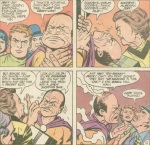
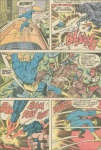
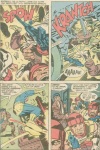


Why are there two Don Rickles, but only one Linda Ronstadt?
Clone her, for cryin’ out loud!
Haha!